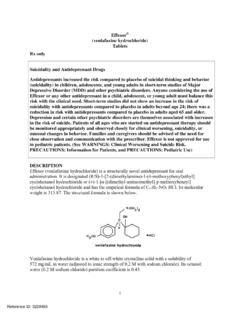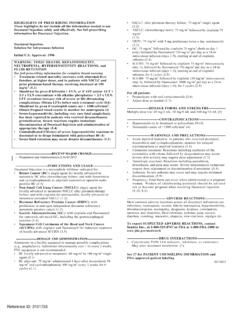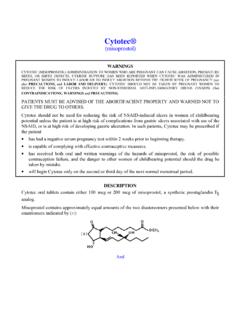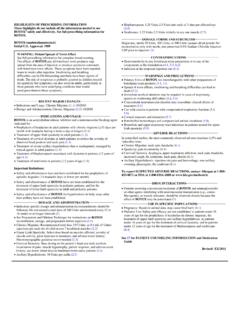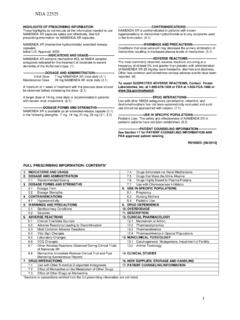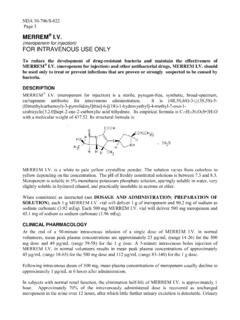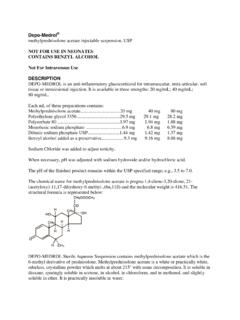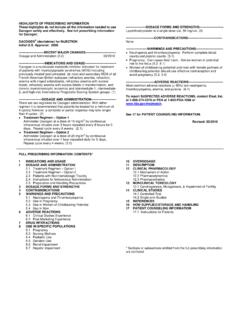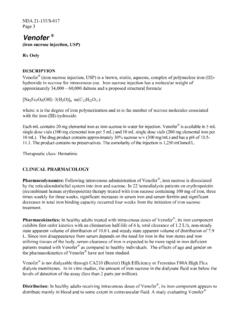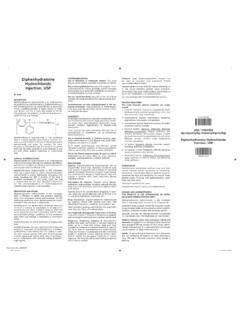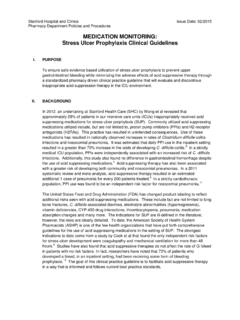Transcription of PRESCRIBING INFORMATION ARGATROBAN
1 NDA 20-883/S-014. Page 4. PRESCRIBING INFORMATION . ARGATROBAN . Injection DESCRIPTION. ARGATROBAN is a synthetic direct thrombin inhibitor derived from L-arginine. The chemical name for ARGATROBAN is 1-[5-[(aminoiminomethyl)amino]-1-oxo-2-[ [(1,2,3,4-tetrahydro-3-methyl-8 . quinolinyl)sulfonyl]amino]pentyl]-4-meth yl-2-piperidinecarboxylic acid, monohydrate. ARGATROBAN has 4 asymmetric carbons. One of the asymmetric carbons has an R configuration (stereoisomer Type I) and an S configuration (stereoisomer Type II). ARGATROBAN consists of a mixture of R and S. stereoisomers at a ratio of approximately 65:35. The molecular formula of ARGATROBAN is C23H36N6O5S H2O. Its molecular weight is The structural formula is shown below: ARGATROBAN is a white, odorless crystalline powder that is freely soluble in glacial acetic acid, slightly soluble in ethanol, and insoluble in acetone, ethyl acetate, and ether.
2 ARGATROBAN Injection is a sterile clear, colorless to pale yellow, slightly viscous solution. ARGATROBAN is available in 250-mg (in ) single-use amber vials, with gray flip-top caps. Each mL of sterile, nonpyrogenic solution contains 100 mg ARGATROBAN . Inert ingredients: 750 mg D-sorbitol, 1,000 mg dehydrated alcohol. CLINICAL PHARMACOLOGY. Mechanism of Action: ARGATROBAN is a direct thrombin inhibitor that reversibly binds to the thrombin active site. ARGATROBAN does not require the co-factor antithrombin III for antithrombotic activity. ARGATROBAN exerts its anticoagulant effects by inhibiting thrombin-catalyzed or -induced reactions, including fibrin formation; activation of coagulation factors V, VIII, and XIII; activation of protein C; and platelet aggregation.
3 ARGATROBAN is highly selective for thrombin with an inhibitory constant (Ki) of M. At therapeutic concentrations, ARGATROBAN has little or no effect on related serine proteases (trypsin, factor Xa, plasmin, and kallikrein). ARGATROBAN is capable of inhibiting the action of both free and clot-associated thrombin. ARGATROBAN does not interact with heparin-induced antibodies. Evaluation of sera in 12 healthy subjects and 8 patients who received multiple doses of ARGATROBAN did not reveal antibody formation to ARGATROBAN (see CLINICAL STUDIES). Pharmacokinetics: Distribution: ARGATROBAN distributes mainly in the extracellular fluid as evidenced by an apparent steady-state volume of distribution of 174 mL/kg ( L in a 70-kg adult).
4 ARGATROBAN is 54% bound to human serum proteins, with binding to albumin and 1-acid glycoprotein being 20% and 34%, respectively. NDA 20-883/S-014. Page 5. Metabolism: The main route of ARGATROBAN metabolism is hydroxylation and aromatization of the 3-methyltetrahydroquinoline ring in the liver. The formation of each of the 4 known metabolites is catalyzed in vitro by the human liver microsomal cytochrome P450 enzymes CYP3A4/5. The primary metabolite (M1) exerts 3- to 5-fold weaker anticoagulant effects than ARGATROBAN . Unchanged ARGATROBAN is the major component in plasma. The plasma concentrations of M1 range between 0%. and 20% of that of the parent drug. The other metabolites (M2 to M4) are found only in very low quantities in the urine and have not been detected in plasma or feces.
5 These data, together with the lack of effect of erythromycin (a potent CYP3A4/5 inhibitor) on ARGATROBAN pharmacokinetics, suggest that CYP3A4/5-mediated metabolism is not an important elimination pathway in vivo. Total body clearance is approximately mL/kg/min ( L/kg/hr) for infusion doses up to 40 mcg/kg/min. The terminal elimination half-life of ARGATROBAN ranges between 39 and 51 minutes. There is no interconversion of the 21 (R):21 (S) diastereoisomers. The plasma ratio of these diastereoisomers is unchanged by metabolism or hepatic impairment, remaining constant at 65:35. ( 2%). Excretion: ARGATROBAN is excreted primarily in the feces, presumably through biliary secretion. In a study in which 14C- ARGATROBAN (5 mcg/kg/min) was infused for 4 hours into healthy subjects, approximately 65% of the radioactivity was recovered in the feces within 6 days of the start of infusion with little or no radioactivity subsequently detected.
6 Approximately 22% of the radioactivity appeared in the urine within 12 hours of the start of infusion. Little or no additional urinary radioactivity was subsequently detected. Average percent recovery of unchanged drug, relative to total dose, was 16% in urine and at least 14% in feces. Pharmacokinetic/Pharmacodynamic Relationship: When ARGATROBAN is administered by continuous infusion, anticoagulant effects and plasma concentrations of ARGATROBAN follow similar, predictable temporal response profiles, with low intersubject variability. Immediately upon initiation of ARGATROBAN infusion, anticoagulant effects are produced as plasma ARGATROBAN concentrations begin to rise. Steady-state levels of both drug and anticoagulant effect are typically attained within 1 to 3 hours and are maintained until the infusion is discontinued or the dosage adjusted.
7 Steady-state plasma ARGATROBAN concentrations increase proportionally with dose (for infusion doses up to 40 mcg/kg/min in healthy subjects) and are well correlated with steady-state anticoagulant effects. For infusion doses up to 40 mcg/kg/min, ARGATROBAN increases in a dose-dependent fashion, the activated partial thromboplastin time (aPTT), the activated clotting time (ACT), the prothrombin time (PT), the International Normalized Ratio (INR), and the thrombin time (TT) in healthy volunteers and cardiac patients. Representative steady-state plasma ARGATROBAN concentrations and anticoagulant effects are shown below for ARGATROBAN infusion doses up to 10 mcg/kg/min (see Figure 1). Figure 1. Relationship at Steady State Between ARGATROBAN Dose, Plasma ARGATROBAN Concentration and Anticoagulant Effect NDA 20-883/S-014.
8 Page 6. Effect on International Normalized Ratio (INR): Because ARGATROBAN is a direct thrombin inhibitor, co-administration of ARGATROBAN and warfarin produces a combined effect on the laboratory measurement of the INR. However, concurrent therapy, compared to warfarin monotherapy, exerts no additional effect on vitamin K dependent factor Xa activity. The relationship between INR on co-therapy and warfarin alone is dependent on both the dose of ARGATROBAN and the thromboplastin reagent used. This relationship is influenced by the International Sensitivity Index (ISI) of the thromboplastin. Data for 2 commonly utilized thromboplastins with ISI. values of (Innovin, Dade) and (Thromboplastin C Plus, Dade) are presented in Figure 2 for an ARGATROBAN dose of 2 mcg/kg/min.
9 Thromboplastins with higher ISI values than shown result in higher INRs on combined therapy of warfarin and ARGATROBAN . These data are based on results obtained in normal individuals (see PRECAUTIONS, Drug Interactions and DOSAGE AND. ADMINISTRATION, Conversion to Oral Anticoagulant Therapy). Figure 2. INR Relationship of ARGATROBAN Plus Warfarin Versus Warfarin Alone Figure 2 demonstrates the relationship between INR for warfarin alone and INR for warfarin co-administered with ARGATROBAN at a dose of 2 mcg/kg/min. To calculate INR for warfarin alone (INRW), based on INR for co-therapy of warfarin and ARGATROBAN (INRWA), when the ARGATROBAN dose is 2 mcg/kg/min, use the equation next to the appropriate curve.
10 Example: At a dose of 2 mcg/kg/min and an INR performed with Thromboplastin A, the equation + (INRWA) = INRW would allow a prediction of the INR on warfarin alone (INRW). Thus, using an INRWA value of obtained on combined therapy: INRW = + (4) = as the value for INR on warfarin alone. The error (confidence interval) associated with a prediction is units. Similar linear relationships and prediction errors exist for ARGATROBAN at a dose of 1 mcg/kg/min. Thus, for ARGATROBAN doses of 1 or 2 mcg/kg/min, INRW can be predicted from INRWA. For ARGATROBAN doses greater than 2 mcg/kg/min, the error associated with predicting INRW from INRWA is 1. Thus, INRW cannot be reliably predicted from INRWA at doses greater than 2 mcg/kg/min.
